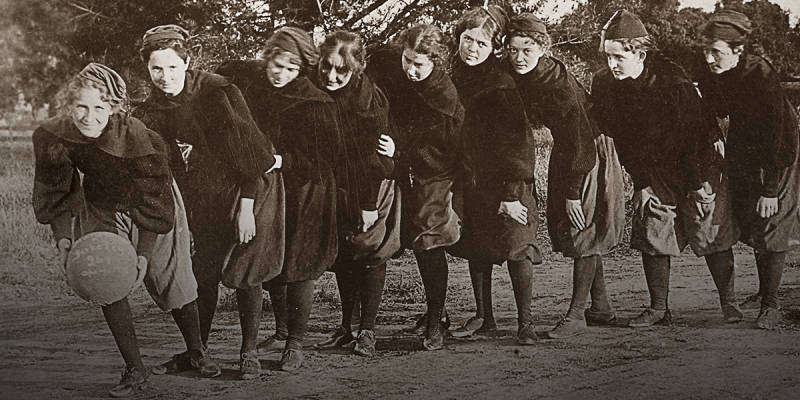SHORTLY AFTER THE gates opened Tuesday night, thousands of fans filed into Maples Pavilion to see the Cardinal play Cal in a women's basketball rivalry that typically matches two of the top teams on the West Coast.
Contrast the scene to one of their first scheduled meetings, in 1898. If there was a crowd, it certainly wasn't welcomed. In fact, the "crowd" of presumably male admirers was probably the reason the game wasn't played at all.
The reason: "Game called off, fence not high enough."
Those were the days when women played in bloomers -- apparently a bit racy for the times. Therefore, women had to participate in sports, or at least basketball, in secret or in front of all-female audiences.
The restrictions and limitations seem like a joke today, on the 30th National Girls and Women in Sports Day, especially at Stanford where women's sports have flourished like no other place.
Stanford women's teams have won an NCAA-best 46 national championships, and 60 altogether. Last year, the Stanford's women’s golf team won its first NCAA title in dramatic fashion, becoming the 11th Cardinal women’s program to win a national title.
* * *
IF ANY SCHOOL can claim to be at the forefront of women's athletics, it's Stanford. The tradition goes back to the early days of the university, when it created an athletics program under the auspices of the Women's Athletic Association in 1893.
Under the original leadership of a student, Mabel Holsclaw, the WAA created sporting opportunities for women in archery, basketball, bicycling, boating, tennis, and track and field. The activities were mostly in-house, at Roble Gym and Roble Field, which were built solely for women's athletics. Encina Gym on the opposite end of campus was the all-male sanctuary.
Roble Gym, built in 1896, was not exactly state of the art. The wooden structure seemed old not long after it was built, and was known as the "Woodpecker Lodge." The structure "would have collapsed if the termites had ever stopped holding hands," wrote Don Liebendorfer in "The Color of Life is Red," and was replaced in 1931.
And yet, within those walls blew the sawdust of opportunity. Did you know that Stanford participated in the first women's intercollegiate athletic contest in the United States?
Stanford women's basketball actually was created before the Stanford men, and the circumstances surrounding its first games seemed unusual in today's light.
How about a 1-0 victory? That was the score of Stanford's first game, over a high school team from Castilleja School in 1896. Obviously, Stanford could have used a little scoring punch (couldn't they have recruited the Ogwumikes' great grandmother?), but must have been happy with the rare hoops shutout.
The historic first game against Cal - won by Stanford 2-1 (another great defensive effort) - had a fence-not-high-enough feel to it.
"No men were admitted to the affair in any capacity until a basket in the ancient San Francisco Armory, where the game was played, broke and the ladies discovered they had neither the tools nor the know-how to make repairs," Liebendorfer wrote. "So, workmen were called in and the California gals discreetly retired to their dressing room until the basket was fixed.
"However, Stanford remained on the floor and continued to shoot at the basket which was whole, in spite of the stares of the repairmen, who were getting their first view of the daring bloomers. History does not record how many smashed thumbs resulted or just how the second bucket managed to break; it may just have rusted through for lack of use."
Changes were happening in society, away from the Victorian-influenced age and into one of active participation.
About this time, a poem appeared in the 1898 Stanford Quad yearbook, with a drawing of a young woman in bloomers and a basketball tucked under her arm, looking up at a painting of her great grandmother.
The poem, entitled "To an Old Portrait (The Basket-ball Girl Speaks)" was a testament to the changing mores of the times, when women were finally encouraged to exercise, and great grandmothers may have had trouble relating to their gym-rat great granddaughters.
"Down the changing century
Out of your dim Yesterday
Into my To-day, I wonder
What you'd think of me."
* * *
EVEN IN THE early 20th century, there were signs of the future. Women's basketball, with today's two NCAA titles, great crowds and remarkable legacy as one of the school's marquee sports, had its origins in the bloomer era. However, as late as 1914, men - except the referee - still were barred from Stanford's games, and women's basketball wouldn't be granted varsity status until 1975.
Tennis also has deep roots in the Stanford tradition. Given Stanford's 18 national women's tennis championships, it's not surprising that the sport's history is long. In 1903, Stanford beat Mills College, 49-26 (an unusual scoring system was in place at the time), in its' first-ever match and then won two of three in singles against Cal. Stanford's "Miss M. Hendrick '03 beat Miss G. Wickson, 8-6, 6-1" at No. 1, according to The Quad.
Fencing, under the coaching of the legendary Harry Maloney, joined the intercollegiate ranks in 1915. Others were to follow. However, until the 1970s, women's intercollegiate athletics were limited, and remained secondary to intramurals or interclass competitions. Exceptions came in sports such as swimming and tennis where individuals could train on their own, or with private coaches and clubs. Stanford's first great women athletes came from aquatics. Clarita Hunsberger was fourth in the 1924 Olympic high-diving competition. Marjorie Gestring won the 1936 Olympic springboard diving title at age 13 - the youngest person ever to win a gold medal, and continued to win national titles while she was at Stanford.
And there was Brenda Helser. A Stanford student in the post-World War II era, the statuesque Helser won 10 national titles, set an American record in the 100-meter freestyle (1:05.8 in 1947) and won Olympic swimming gold in the 400 free relay in 1948. She later married a French nobleman and became known as the Countessa de Morelos.
* * *
TENNIS USHERED IN the modern era of Stanford women's sports, partly through the influence of Julie Heldman and Janie Albert, the daughter of Stanford quarterbacking great Frankie Albert.
In 1964, the Athletic Association of Western Universities (now the Pac-12 Conference) held its first women's tennis tournament at Stanford, which won every match and claimed both pairings in the singles and doubles finals.
Albert, with her father too nervous to sit, beat Heldman, 6-2, 6-1, and then went on to beat her teammate again to win the National Collegiates in Greensboro, N.C.
Albert retired from tennis upon graduation, but Heldman went on to a sterling post-collegiate career, winning 22 pro tennis titles, capturing two Federation Cups with the U.S. team, advancing to the semifinals of the Australian, French, and U.S. opens, and reaching a world ranking of No. 5 in 1969.
But Heldman's greatest influence came from a courageous decision. Heldman and eight other women's tennis pros, including Billie Jean King and Rosie Casals, left the U.S. Tennis Association as a protest to the inequality of pay -- as much as a 12:1 ratio between men and women at the same tournaments - to play in the upstart and unsanctioned Virginia Slims tournament in Houston, created by Julie's mother, Gladys, in 1970.
The group became known as the "Original 9," and because the event was so successful, the Virginia Slims tour was created, living the cigarette company's slogan, "You've come a long way, baby." The tour evolved into today's Women's Tennis Association, with millions available in prize money on a worldwide circuit.
Change was inevitable even before Title IX became law in 1972, abolishing discrimination based on sex. But the amendment pushed the process a little faster.
* * *
WHAT WOULD THE poet's great grandmother have thought of Janet Buchan in 1980? The Stanford freshman continued to swim throughout the season despite a painful shoulder injury, but persevered to score a team-high 81 points at the AIAW championships and lead her team to its first national championship. The injury was so severe that Buchan would be unable to compete the following season.
"Everyone on the team knew she was swimming in pain," said her coach Claudia Kolb Thomas, in Gary Cavalli's 1982 book, "Stanford Sports." "She would swim until she couldn't stand it anymore, then start crying and have to get out of the pool.
"At the nationals, she was super. She was the key to our championship ... a real inspiration."
Stanford women's athletics is made up of hundreds of such inspirational stories among its 20 sports. And because of such dedication, has grown into the most successful women's sports program in the nation.
Women's tennis won its first national title in 1978, women's swimming and diving in 1980, women's basketball in 1990, women's volleyball in 1992, women's cross country in 1996, synchronized swimming in 1998, women's water polo in 2002, women's rowing in 2009, women's lightweight rowing in 2010, women's soccer in 2011, and women’s golf in 2015.
Clearly, no fence can stop the Cardinal women now.
An original version of this story appeared on GoStanford.com on Jan. 31, 2012.











